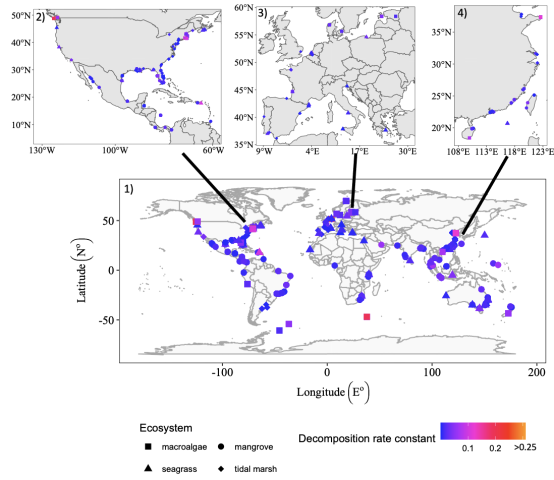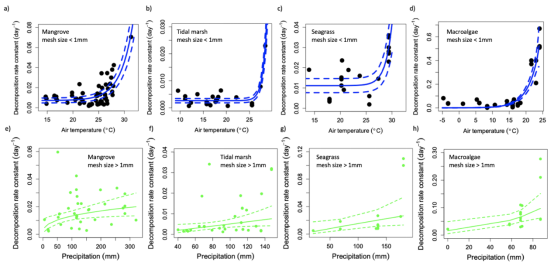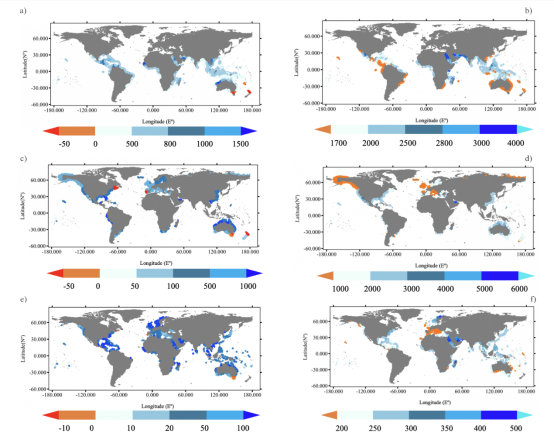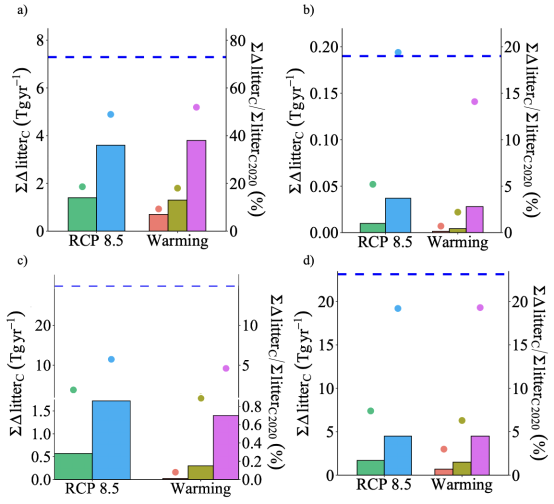The team led by Yang Zhifeng at the Southern Marine Science and Engineering Guangdong Laboratory (Guangzhou) has made progress in understanding how the decomposition of macrophyte and algal litter in global blue carbon ecosystems responds to climate change. The findings were published in the SCI journal Global Change Biology (Impact Factor: 13.211) under the title "Response of macrophyte litter decomposition in global blue carbon ecosystems to climate change." The first author and corresponding author of the paper is Researcher Ouyang Xiaoguang from Southern Marine Science and Engineering Guangdong Laboratory (Guangzhou). Collaborating institutions include Guangdong University of Technology, The Chinese University of Hong Kong, University of Southern Denmark, Leibniz Centre for Tropical Marine Research, and The University of Rhode Island.
Blue carbon ecosystems (BCEs) are an important natural solution for mitigating climate change. However, current debates have raised questions about the reliability and contribution of BCEs in future climate change scenarios. Most data on the impact of climate change on litter decomposition is derived from terrestrial ecosystems, with few studies revealing the potential changes in litter decomposition within BCEs under different climate change scenarios.
This study aims to improve the accounting of carbon sinks in blue carbon ecosystems by examining the response of litter decomposition from macrophytes and algae to future climate change. Through a meta-analysis of 309 global studies (Figure 1), the research found that: (1) the average decomposition rate constant (k-value) of macroalgae litter is higher than that of seagrasses, mangroves, and salt marshes; (2) the k-values of macrophytes and algae show a double exponential positive correlation with temperature (Figure 2) and are also positively correlated with rainfall. The k-value for intertidal seagrasses increases with rising temperature and precipitation, whereas the k-value for subtidal seagrasses increases with rising sea surface temperature; (3) above the temperature thresholds of vascular plant litter (~25°C) and macroalgal litter (~20°C), k rises sharply with temperature. Compared to controlled laboratory experiments, significant local to global factors lead to deviations from the single exponential model in field experiments. This study defines fundamental and realistic temperature feedbacks to explain this phenomenon; (4) mangrove and salt marsh ecosystems respond more strongly to climate change than seagrass ecosystems; (5) compared to 2020, it is predicted that the net litter carbon sink from macroalgae in BCEs will increase by 0.32 Tg (0.28-0.50 Tg) by 2100 (Figures 3 and 4). Considering the uncertainty in the area of BCEs due to future sea-level rise, the net litter carbon sink from macroalgae BCEs in 2100 is projected to increase by 0.3 to 0.6 Tg compared to 2020. These results suggest that BCEs may play an even more significant role in mitigating climate change in the future than they do today.
The findings of this study will aid in limiting the carbon sink capacity of BCEs under future climate change scenarios. In addition, the results estimate the litter carbon sink by 2100 based on decomposition rate constant k, litter production, and climate change. These findings will help assess the role of BCEs in carbon reduction for future Nationally Determined Contributions (NDCs), thus leading to more accurate accounting of carbon sinks in blue carbon ecosystems in the future.
This research was funded by key projects from the National Natural Science Foundation, general projects, the Belt and Road International Scientific Organization Alliance collaborative research project, and the PI project of the Southern Marine Science and Engineering Guangdong Laboratory (Guangzhou), among others.
Full paper: Ouyang, X., Kristensen, E., Zimmer, M., Thornber, C., Yang, Z., & Lee, S. Y. (2023). Response of macrophyte litter decomposition in global blue carbon ecosystems to climate change. Global Change Biology, doi:10.1111/GCB.16693.

Figure 1 shows the distribution of litter decomposition experimental sites in global blue carbon ecosystems.

Figure 2 illustrates the relationship between litter decomposition rate constant (k) and temperature and rainfall in field experiments.

Figure 3 depicts changes in carbon release from litter decomposition in blue carbon ecosystems in 2050 and 2100 compared to 2020 (units: kg C/(ha·year)).

Figure 4 presents the changes in carbon release during future litter decomposition in blue carbon ecosystems under different climate change scenarios compared to 2020.
Attachment download:
